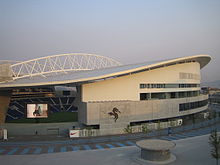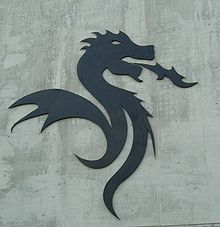- Estádio do Dragão
-
Estádio do Dragão 
Estádio do Dragão (north view)Location Porto, Portugal Coordinates 41°09′42″N 8°35′02″W / 41.161758°N 8.583933°WCoordinates: 41°09′42″N 8°35′02″W / 41.161758°N 8.583933°W Opened November 16, 2003 Owner F.C. Porto Operator Porto Estádio
(F.C. Porto Group)Surface Grass Scoreboard Two 48-square-metre (520 sq ft) SLite 10 LED screens (Barco) Construction cost €98 million Architect Manuel Salgado (Portugal) General Contractor Somague Capacity 50,399 (football)[1] Record attendance 52,004
(vs. F.C. Barcelona, November 16, 2003)Website fcporto.pt Tenants F.C. Porto (2003–present) The Estádio do Dragão (English: Dragon Stadium; literally Stadium of the Dragon) is a football stadium located in Porto, Portugal, with an all-seated capacity of 50,399.[1] Inaugurated on November 16, 2003, it is the current home ground of F.C. Porto, having replaced the club's old venue, the Estádio das Antas (English: Antas Stadium). It is a certified UEFA category four stadium, and was one of the venues of the UEFA Euro 2004.
Contents
Construction and inauguration
Construction works began in late 2001, and were complete in November 2003, some months after what was expected, since in February 2002, Porto mayor Rui Rio changed the estate distribution, criticizing the plan for including high-scale housing and shopping for the area. These actions forced the chairman of F.C. Porto, Jorge Nuno Pinto da Costa, to halt all building operations, which were only resumed after a consensus was reached.
Designed by Portuguese architect Manuel Salgado and built by Portuguese contractor Somague, it cost €97,755,318, of which €18,430,956 was subsidized by the government. To help underwrite costs, each stand carries one or two sponsor names: Super Bock (south), tmn (east), meo (west), and Coca-Cola (north stand). Away fans are placed in the left corner of the north stand, while home Ultra groups, Super Dragões and Colectivo Ultras 95, occupy the south stand and the north stand, respectively, like on the old stadium.
The stadium was inaugurated on November 16, 2003, with a match against F.C. Barcelona, which featured the debut of a 16-year-old Lionel Messi in the Catalan side. Porto won 2–0 with goals by Derlei and Hugo Almeida. Due to severe turf problems, however, Porto was forced to return and play in the old Estádio das Antas, until the turf was replanted by mid-February 2004.
Naming
The stadium's name is derived from the presence of a dragon on the club's crest, which is composed of an old stitched leather football under the city's coat of arms. It is also the nickname of the club's football team. Other alternatives were considered, such as keeping the old name, Estádio das Antas (officially, unlike the former stadium), or name after former player Pinga, former manager José Maria Pedroto, or president Pinto da Costa (holding office since 1982).
Major events
Constructed to become one of the venues of the UEFA Euro 2004 tournament, it staged the inaugural match between hosts Portugal and eventual winners Greece, as well as three group stage, one quarterfinal, and one semifinal fixtures. The stadium further cemented its reputation as an all-round sports and entertainment venue when it hosted the Portuguese leg of The Rolling Stones 2006 world tour, and the 2009 Race of Champions South Europe finals.
Portugal national football team
The following national team matches were held in the stadium.
# Date Score Opponent Competition 1. 12 June 2004 1–2  Greece
GreeceEuro 2004 Group Stage 2. 12 October 2005 3–0  Latvia
LatviaWorld Cup 2006 qualification 3. 21 November 2007 0–0  Finland
FinlandEuro 2008 qualifying 4. 28 March 2009 0–0  Sweden
SwedenWorld Cup 2010 qualification 5. 8 October 2010 3–1  Denmark
DenmarkEuro 2012 qualifying 6. 7 October 2011 5–3  Iceland
IcelandEuro 2012 qualifying References
- ^ a b "História Dos Estádios" (in Portuguese). FC Porto.pt. http://www.fcporto.pt/Clube/HistoriaEstadios/historiaestadios.asp.
External links
- The most complete reference about the stadium, at www.fcporto.ws
- Estádio do Dragão @ FC Porto's official website
- 3D Model of F.C.Porto Stadium - Google 3D Warehouse
Futebol Clube do Porto Grounds Training Ground Rivalries O Clássico · Sporting CP rivalryMiscellaneous Other sports Main Portuguese football stadia D. Afonso Henriques · Algarve · Alvalade · Aveiro · Barreiros · Bessa · Bonfim · Braga · Cidade de Coimbra · Dragão · Luz · Magalhães Pessoa · Nacional (Jamor) · ResteloCategories:- F.C. Porto
- Football venues in Portugal
- UEFA European Football Championship stadiums
Wikimedia Foundation. 2010.


